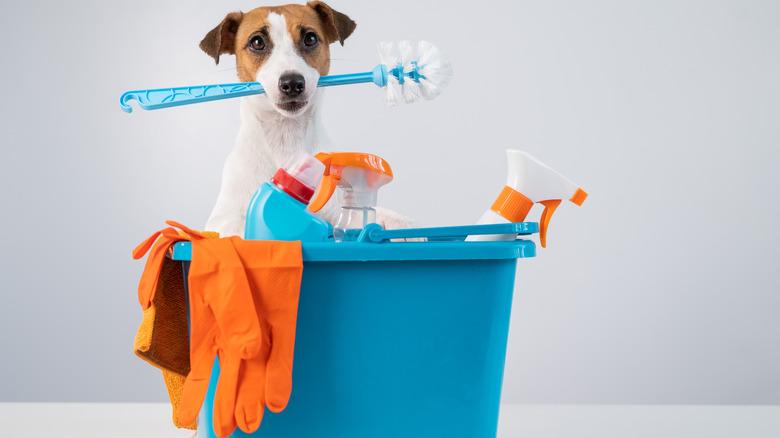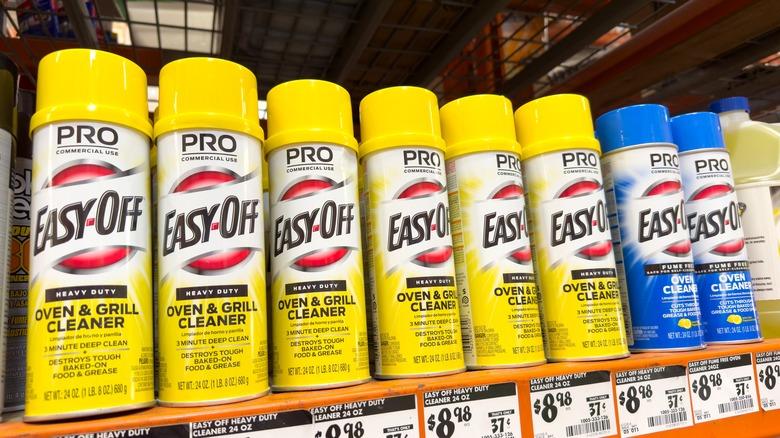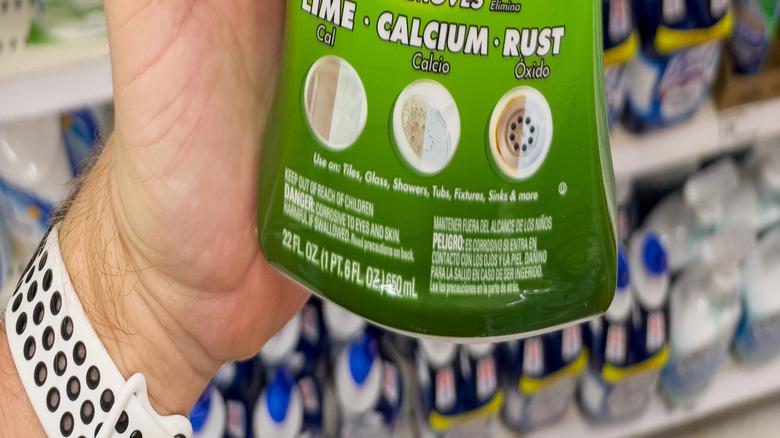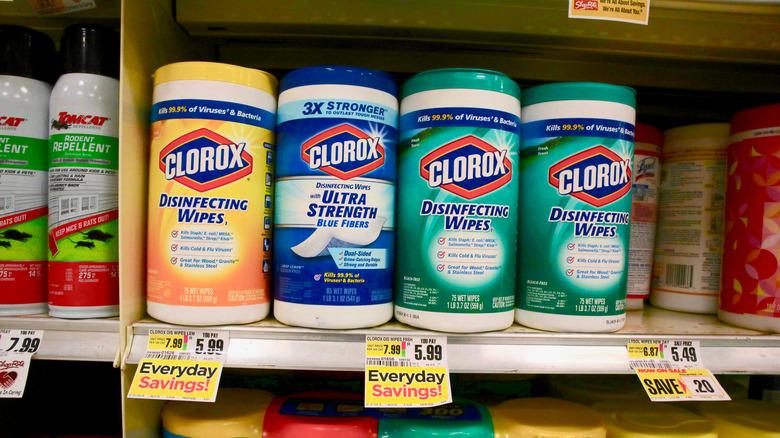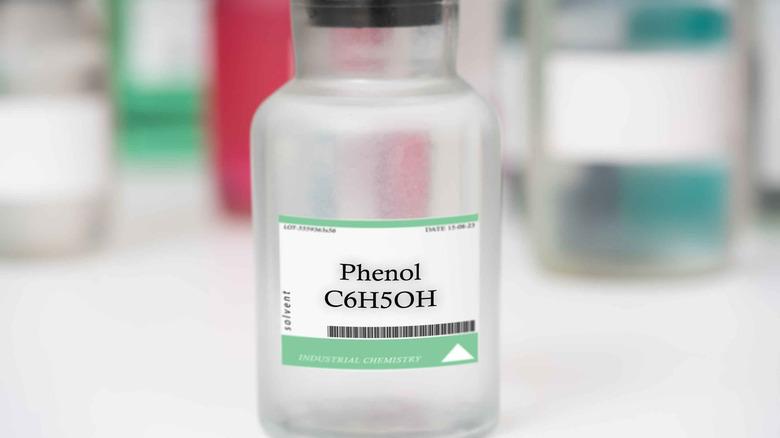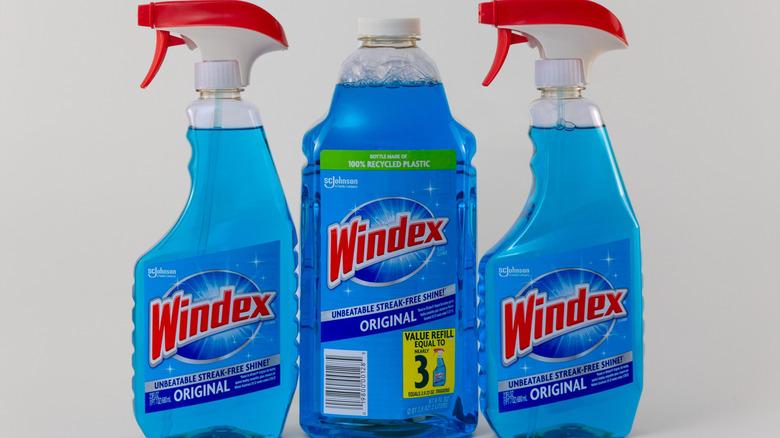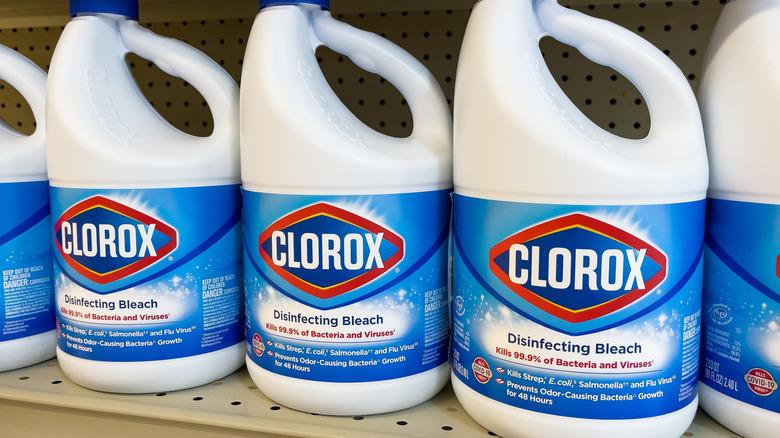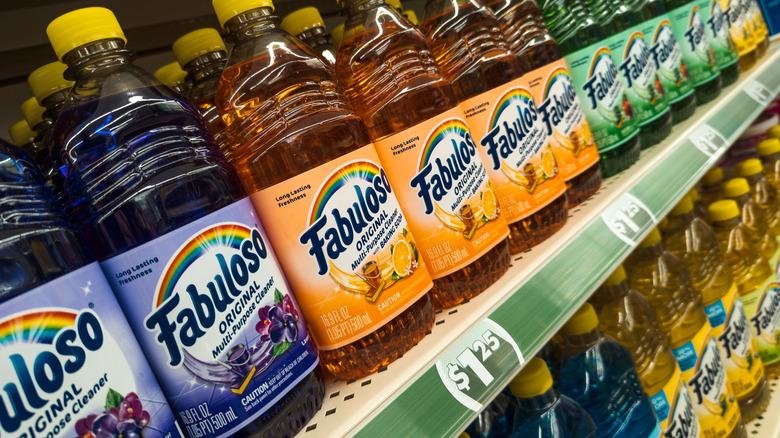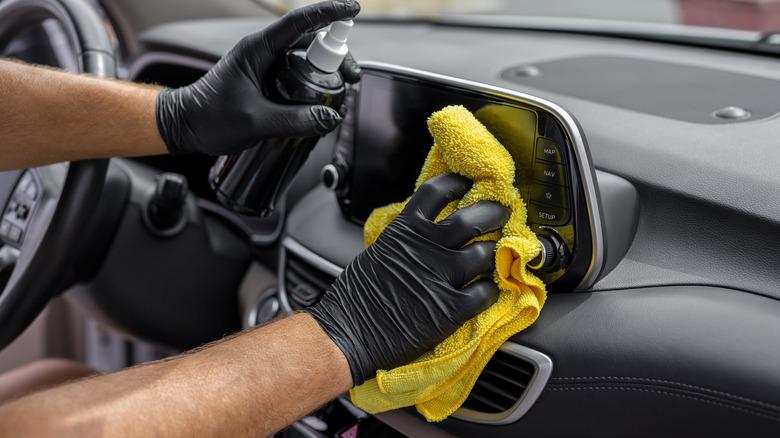10 Common Cleaning Products To Avoid Using If You Have Pets In Your Home
There are so many common cleaning products that are terrible for your health, and they can be even more harmful to pets, whose smaller bodies and heightened sensitivity make them more vulnerable to toxic exposure. In fact, a dog's sense of smell is estimated to be 1,000 to 10,000 times more powerful than ours, and both dogs and cats have over 200 million smell receptors. So, if the chemical smell or strong fragrance is mildly annoying to you, it's probably extremely uncomfortable to four-legged friends. Unfortunately, the effects of inhaling these toxic fumes can be more hazardous than discomforting, with some products causing severe respiratory issues. Inhalation isn't the only concern, either. Pets can absorb chemicals through their paw pads when walking across freshly cleaned surfaces, and they often ingest toxins when grooming themselves afterward.
With animals roaming through the house, keeping it clean can feel like an endless task. Every surface of your home will need a good scrubbing at some point, so it's important to check the ingredient labels of any products you plan to use around pets. Unfortunately, chemical names often look like a cat walked across the keyboard, making it hard to know what's actually dangerous. If you're unsure which ingredients to avoid, the list below breaks down some of the most common name brands and the toxic chemicals hiding inside them.
Easy-Off can cause severe burns to your pet's skin, eyes, and windpipe
Cleaning an oven can be a huge pain, especially when last night's dinner dripped out of the pan and transformed into hardened gunk. Many people turn to Easy-Off, a popular oven and grill cleaner that effectively cuts through grease and tough food stains. It contains a powerful ingredient, lye, a strong alkaline substance that can dissolve animal proteins, making it useful in soaps and cleaners. However, it's also a big reason this product is toxic to animals. If your pet comes into contact with it or ingests even a small amount, it can cause painful burns to their eyes, skin, or digestive tract, and in severe cases, may even require surgery. Just inhaling the fumes can also irritate their respiratory system and cause serious respiratory issues.
Lye isn't just in oven cleaners; it's also a common additive in drain clog removers, like Drano. When checking the ingredients of degreasing products, keep an eye out for lye, which may also be listed as sodium hydroxide or caustic soda. If you want to clean your oven without harsh chemicals, you can make a pet-friendly cleaner by mixing ½ cup of baking soda with 3 tablespoons of water to create a paste. Cover any grimy areas, let the mixture sit for about 15 minutes, and wipe it away. Use a wet paper towel to clean up any leftover grease and stains.
Acidic tub and tile cleaners can lead to serious gastrointestinal issues
Just like high alkaline cleaners can be toxic for pets, so are those with an extremely low pH. Acidic ingredients are the go-to for tub and tile cleaners because they work well to dissolve minerals that cause hard water stains, calcium deposits, limescale, and other types of common bathroom buildup. Acid poisoning can affect dogs, cats, and other animals through ingestion, inhalation, or even direct contact with the substance. Highly concentrated acids can immediately cause painful burns or ulcers, potentially harming the eyes, lungs, or gastrointestinal tract. If your dog or cat has acid poisoning, they may whimper, paw at the affected area, have swollen eyes, drool, vomit, or even struggle to breathe.
Some common acids to look out for include hydrochloric, sulfuric, nitric, and phosphoric acid. In addition to bathroom cleaners, they're also found in swimming pool cleaners, metal cleaners, drain cleaners, and others. Although popular acidic alternatives like vinegar can be toxic in large doses, it's generally okay to clean with diluted mixtures as a safer option. However, there's another inexpensive kitchen staple you can use to clean your bathroom: a lemon. Simply cut the fruit in half and rub it on your tub, tile, faucets, or any other spot with hard water stains or limescale. The acidic lemon juice will make your bathroom look sparkling clean, leave behind a fresh scent, and is safe to use around furry friends as long as you wipe it down before they walk on it and don't let them ingest it.
Disinfectant sprays and wipes with quats can cause painful mouth ulcers in cats
Cleaning wipes may be handy to have around, but many brands contain chemicals that are toxic to animals. Quats (quaternary ammonium compounds) are a group of chemicals that excel at killing germs and viruses, so they're often added to disinfecting sprays or disposable wipes. These substances can harm dogs and other animals, but cats are especially sensitive to their toxic effects. When you clean your counters with products that contain quats, your cat might unknowingly walk through the residue and ingest it later while grooming. Even products with low concentrations can cause painful ulcers to develop in their mouth and throat.
Quats cover a wide range of chemicals, so it's important to look into any disinfectant you bring into the home. If you have cats, it's best to avoid products containing quats altogether. Luckily, dish soap and warm water are typically all you need to get your counters clean. Not only is it much safer to use around four-legged friends, but it's also less damaging to your counters than acidic or alkaline chemicals. If necessary, you can add rubbing alcohol to the suds to add a more pet-safe disinfectant. No matter what you use, it's always a good idea to keep your cats in another room while you clean. Then, rinse off the surface with a wet rag and let it dry before you let them back in.
Pine oil cleaners can cause seizures, liver damage, and more
It's become a popular trend to use essential oils for cleaning solutions because they naturally smell great, tend to be less toxic than commercial cleaners, and many have antimicrobial, antiviral, or antifungal properties. Despite their fame for being a safer alternative, this isn't always the case if you have a home with pets. Pine oil is one of the more common essential oils added to cleaning products, but it's dangerous to use around your furry housemates. It can be toxic if inhaled, absorbed through the paws, or ingested, potentially causing liver damage, kidney damage, gastrointestinal problems, and even central nervous system issues. Pine oil is also shown to cause seizures in dogs, which can be fatal.
Avoid any products that use pine oil or other potentially toxic scents. Whether you're purchasing a cleaner or making your own, you'll also want to stay away from tea tree, eucalyptus, ylang-ylang, clove, and several others. Additionally, many strong fragrances in cleaners contain phthalates, which can cause hormonal imbalances and even tumors in pets, so it's best to avoid all scented products. To make a pet-safe multi-purpose cleaner, combine equal parts filtered water and vinegar in a spray bottle. Give it a shake to combine, and use it nearly anywhere in your home, from inside your microwave to the toilet bowl (just don't use it on porous natural stone). It may not smell as great at first, but it's a powerful deodorizer that eliminates odors rather than covering them up.
Phenol-based cleaners can be deadly for cats
Nearly every pet owner has walked into the bathroom to see Fido drinking out of the toilet. Because it fills up with fresh, cool water with every flush, dogs just see a giant bowl that's made for them. Although clean toilet water is generally harmless for pets, leftover chemicals from cleaners can be an issue. Many toilet bowl cleaning products contain phenols, a corrosive organic compound that destroys protein cells, making it extremely toxic to animals. For dogs, symptoms can include necrosis of the skin or mucous membranes and can even affect the central nervous system. However, cats, birds, and some reptiles tend to be more sensitive to this ingredient. In severe cases, ingesting phenol can cause liver failure, kidney failure, and even death for pets.
Although many companies are stepping away from phenols, these ingredients are still sometimes found in toilet bowl cleaners and disinfectants. As with most toxic ingredients, it's best to avoid using any products that contain them. For a pet-safe toilet bowl cleaner, sprinkle a cup of baking soda all around the inside of the toilet. Then, follow up by pouring or spraying vinegar on top and watch the magic happen. As the chemicals react, it'll foam up, breaking down dirt, grime, and odors. Once it finishes fizzing, work in the mixture using a scrub brush, and flush.
Ammonia-based cleaners can irritate your pet's respiratory tract
Windex is a go-to brand for many who want to keep everything from windows to TV screens looking shiny and new. The key ingredient in most glass cleaners is ammonia, an extremely toxic chemical that should be used with care (whether you stand on two or four legs). If your pet inhales ammonia, it can burn their mucus membranes, and over time, they may develop a cough or struggle to breathe. If the exposure persists, they may even develop a respiratory disease. On the other hand, if your curious pup or kitty licks up the residue or taste-tests a spilled bottle, it can burn their mouth or nose and cause nausea and vomiting.
Ammonia isn't just in glass cleaners; it can also be found in stainless steel cleaning products, furniture polishes, toilet bowl cleaners, and oven cleaners. Although most of the time it's diluted, repeated exposure can still put animals at risk. To make a safer glass-cleaning alternative, combine equal parts distilled white vinegar and water with a few drops of lemon juice. The vinegar will cut through common glass stains, leaving behind a streak-free shine, while the lemon juice offers a refreshing scent. If there's a lot of buildup, use a rag soaked in soapy water to remove grime before finishing with the vinegar solution.
Household bleach can trigger seizures, coma, or respiratory issues
Most of us know the dangers of Clorox bleach fumes, especially when combined with other chemicals. However, even if you don't mix it, you'll still need to be careful when using this whitening agent around pets. There are a few chemicals in Clorox bleach, but the main active ingredient is sodium hypochlorite, a corrosive substance that whitens and disinfects. These are great traits when it comes to removing tough stains or ridding the home of germs, but it's also what makes bleach hazardous. Household bleaches tend to have low concentrations, though they can still cause symptoms like lethargy, vomiting, diarrhea, and dehydration when consumed. When inhaled, it can burn a pet's respiratory tract, cause blood imbalances, and harm their kidneys. If enough is ingested, the effects can escalate to seizures or comas. Clorox Concentrated is made up of 8.25% sodium hypochlorite, so it takes a smaller amount to trigger a toxic reaction in animals.
Like with many chemicals, it's important to keep pets and children in another room while you're using them. If necessary, invest in pet-proof locks to keep nosy animals from finding your tubs of bleach. For a safer bleaching agent that also works well to deodorize, disinfect, and kill mold, consider switching to hydrogen peroxide. It's a potent, but eco-friendly alternative that effectively breaks down organic matter, removes stains, and kills germs just as well as the toxic stuff, and the fumes are generally not dangerous to pets in normal cleaning quantities.
Laundry and dishwasher pods are a major choking and toxicity risk
It's easy to overlook laundry or dishwashing products as a threat, but just because you don't spray them in the air or use them to wipe down surfaces doesn't mean they're in the clear. While pets aren't usually interested in the bottles, these soaps can be risky when spilled. If your cat walks through the sticky puddle, grooms herself, and ingests detergent, the corrosive agents inside the liquid can cause serious issues. You may notice symptoms like vomiting, drooling, lethargy, difficulty breathing, and at worse, your pet could develop aspiration pneumonitis. Laundry and dishwasher pods pose an even bigger risk, as they're a major choking hazard. To cats, they can look like a small toy to swat around, and food-motivated dogs may mistake them for a treat. Additionally, between the coloring, perfumes, and surfactants, pods are a toxic concoction that can cause significant stomach issues.
While they may be convenient, it's best to skip the pods if you have animals or kids in your home. To prevent any chance of a pet ingesting detergents, always clean up spills immediately and rinse with water. If you want to switch to a more pet-friendly laundry product, consider trying castile soap. It's a vegetable-based cleaner that's safe for use around pets (and even on them when diluted properly, as long as it doesn't contain additional essential oils). To add a natural bleaching agent to your whites, a cup of hydrogen peroxide per load is a great alternative to fight stains.
Fabuloso's intense fragrance can cause respiratory issues and stomach irritation
This bright-colored cleaner may be popular for its cleaning ability at a low cost, but the mix of chemicals it contains can be dangerous to have around pets. One of its active ingredients, sodium dodecylbenzenesulfonate, is what makes Fabuloso break down dirt and grime so well. Unfortunately, it can cause skin or eye irritation if a pet comes in contact with it. It also may contain glutaral, or glutaraldehyde, a strong disinfectant, which is potentially carcinogenic and can cause respiratory issues when inhaled. Sodium sulfates are also included in this cleaner. If a pet ingests it or licks it off themselves, it can cause gastrointestinal upset or burn their esophagus, small intestine, and stomach lining.
Fabuloso is one of the last multi-cleaners you'll want to use around your furry friends, especially on floors. Pets spend most of their time on the ground, so it's incredibly important to make sure they have a safe area to walk on. Even if you opt for a different floor cleaner, go with one that doesn't rely on harsh chemicals to get the job done. Luckily, there are several eco- and pet-friendly DIYs you can try. Castile soap is one of the best options, especially if you're looking for a gentle cleanser for flooring like hardwood. Simply add water to your mop bucket and mix in 2½ tablespoons of castile soap for each gallon you add, then mop as you usually would.
Car interior cleaners contain many of the same toxic chemicals as household cleaners
When thinking about pet-safe cleaners, it's easy to forget products used to clean the car. If your pooch is a regular passenger when going to the park or along for a drive, you'll want to make sure you're limiting harsh chemicals. Aside from the notoriously dangerous, like antifreeze, many products used to clean the interior and windows have the same toxic ingredients as household cleaners, like ammonia, phenols, and bleach. While not technically a cleaning product, it's important to note that car fresheners can be dangerous as well. Similar to scented house cleaners, they can contain fragrances that can irritate their airways.
Just like when cleaning your home, keep pets in another area during the cleaning process. Wait until the windows and interior are completely dry before letting them hop back in. You may also want to let it air out for a bit if there's an intense chemical smell. Some of the swaps listed above, like using a vinegar solution as a window cleaner, can be applied to vehicles. For others, pet-safe enzymatic cleaners are a good alternative to deep clean the interior without putting your pup at risk.
